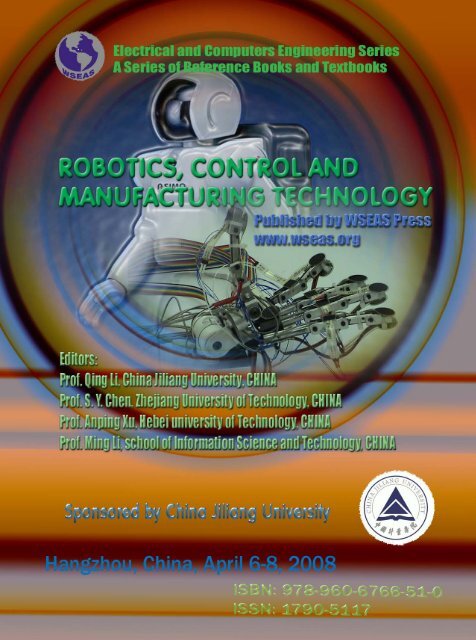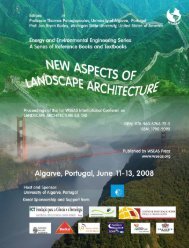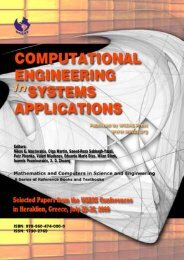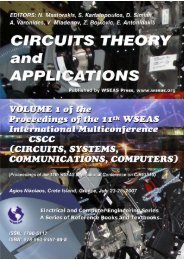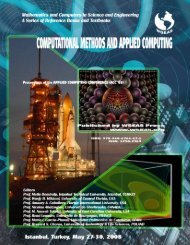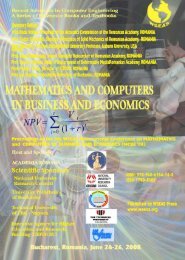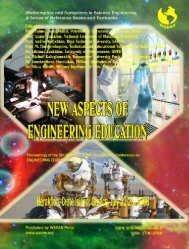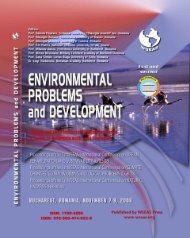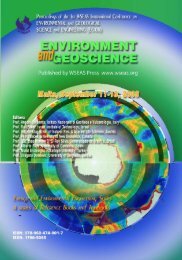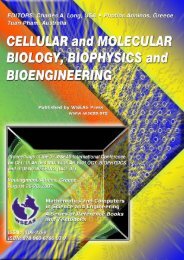Robotics-Control-and.. - WSEAS
Robotics-Control-and.. - WSEAS
Robotics-Control-and.. - WSEAS
- No tags were found...
You also want an ePaper? Increase the reach of your titles
YUMPU automatically turns print PDFs into web optimized ePapers that Google loves.
ROBOTICS, CONTROL ANDMANUFACTURING TECHNOLOGYProceedings of the 8th <strong>WSEAS</strong> InternationalConference on ROBOTICS, CONTROL <strong>and</strong>MANUFACTURING TECHNOLOGY (ROCOM '08)Hangzhou, China, April 6-8, 2008Electrical <strong>and</strong> Computers Engineering SeriesA Series of Reference Books <strong>and</strong> TextbooksPublished by <strong>WSEAS</strong> Presswww.wseas.orgISBN: 978-960-6766-51-0ISSN: 1790-5117
ROBOTICS, CONTROL ANDMANUFACTURING TECHNOLOGYProceedings of the 8th <strong>WSEAS</strong> InternationalConference on ROBOTICS, CONTROL <strong>and</strong>MANUFACTURING TECHNOLOGY (ROCOM '08)Hangzhou, China, April 6-8, 2008Electrical <strong>and</strong> Computer Engineering SeriesA Series of Reference Books <strong>and</strong> TextbooksPublished by <strong>WSEAS</strong> Presswww.wseas.orgCopyright © 2008, by <strong>WSEAS</strong> PressAll the copyright of the present book belongs to the World Scientific <strong>and</strong>Engineering Academy <strong>and</strong> Society Press. All rights reserved. No part of thispublication may be reproduced, stored in a retrieval system, or transmittedin any form or by any means, electronic, mechanical, photocopying, recording,or otherwise, without the prior written permission of the Editor of WorldScientific <strong>and</strong> Engineering Academy <strong>and</strong> Society Press.All papers of the present volume were peer reviewed by twoindependent reviewers. Acceptance was granted when both reviewers'recommendations were positive.See also: http://www.worldses.org/review/index.htmlISBN: 978-960-6766-51-0ISSN: 1790-5117World Scientific <strong>and</strong> Engineering Academy <strong>and</strong> Society
ROBOTICS, CONTROL ANDMANUFACTURING TECHNOLOGYProceedings of the 8th <strong>WSEAS</strong> InternationalConference on ROBOTICS, CONTROL <strong>and</strong>MANUFACTURING TECHNOLOGY (ROCOM '08)Hangzhou, China, April 6-8, 2008Editors:Prof. Qing Li, China Jiliang University, CHINAProf. S. Y. Chen, Zhejiang University of Technology, CHINAProf. Anping Xu, Hebei university of Technology, CHINAProf. Ming Li, school of Information Science <strong>and</strong> Technology, CHINA
International Program Committee Members:Gerardo Acosta, SPAINValeri Mladenov, BULGARIA,Ping An, CHINAAhmed Dalalah, JORDANYuejun An, CHINAAndris Buikis, LATVIAKiyoshi Akama, JAPANSaeed Daneshm<strong>and</strong>, IRANJosef Börcsök, GERMANYMetin Demiralp, TURKEYPeter Holub, GERMANYChie Dou, TAIWANAli Al-dahoud, JORDANGuolin Duan, CHINAYasar Amin, PAKISTANManuel Duarte-Mermoud ,CHILEMehrdad Ardebilipour, IRANOdysseas Efremides, GREECECarlos Aviles-Cruz, MEXICOJose Carlos Quadrado, PORTUGALYun Bai AUSTRALIAToshio Eisaka, JAPANShahid Ikramullah Butt, PAKISTANOdysseas Pyrovolakis, GREECEAna Madureira, PORTUGALFrank Ekpar, JAPANAlex<strong>and</strong>er Zemliak, MEXICOEyas El-Qawasmeh, JORDANPetr Ekel, BRAZILAlberto Escobar, MEXICOMoh'd belal Al-Zoubi, JORDANKwo-Jean Farn, TAIWANPoorna Balakrishnan, INDIAAless<strong>and</strong>ra Flammini, ITALYSorin Borza, ROMANIAAthina Lazakidou, GREECEYue-shan Chang, TAIWANJose-Job Flore-Godoy, MEXICOAlex<strong>and</strong>er Grebennikov, MEXICOJoseph Fong, HONG KONG S.A.R.Huay Chang, TAIWANKostas Siasiakos, GREECEOlga Martin, ROMANIA,Donata Francescato, ITALYChin-chen Chang, TAIWANTapio Frantti, FINLANDChip Hong Chang, SINGAPOREGeorges Fried, FRANCESheng-Gwo Chen, TAIWANRocco Furferi, ITALYMin-Xiou Chen, TAIWANJames Gao, UNITED KINGDOMGeorge Antoniou, USAZong Geem, USATanglong Chen, CHINAAhmad Ghanbari, IRANLotfi Zadeh, USAGilson Giraldi, BRAZILWhai-En Chen, TAIWANPanos Pardalos, USAYuehui Chen, CHINAWanwu Guo, AUSTRALIAToly Chen, TAIWANSungho Ha, KOREAMichael Wasfy, USAAmauri Caballero, USATa-Cheng Chen, TAIWANAamir Hanif, PAKISTANC. Manikopoulos, USAIraj Hassanzadeh, IRANChin-Mou Cheng, TAIWANNualsawat Hiransakolwong, THAILANDYaoyu Cheng, CHINARong-Lain Ho, TAIWANChin-Mou Cheng, TAIWANSeyed Ebrahim Hosseini, IRANMyeonggil Choi, KOREAWen Hou, CHINAYuk Ying Chung, AUSTRALIAShih-Wen Hsiao, TAIWAN
Mingsheng Hu, CHINAShyh-Fang Huang, TAIWANA. Manikas, UKChenn-Jung Huang, TAIWANYu-Jung Huang, TAIWANGuo-shing Huang, TAIWANChenn-Jung Huang, TAIWANDil Hussain, DENMARKPhilippe Dondon, FRANCE,Muhammad Ibrahimy, MALAYSIAApostolos Ifantis, GREECEShiming Ji, CHINAZhang Ju, CHINALiu Jun, CHINAMichael Katchabaw, CANADASeong Baeg Kim, KOREAJin-tae Kim, KOREAYoung Jun Kim, KOREAMallikarjun Kodabagi, INDIAVicenzo Niola, ITALYM. I. Garcia-Planas, SPAINInsoo Koo, KOREAYoung-doo Kwon, KOREAVincent Lee, AUSTRALIAHsien-da Lee, TAIWANWeimin Li, CHINAQin Li, CHINADaoliang Li, CHINABo Li, CHINAVitaliy Kluev, JAPANDaoliang Li, CHINAXiaoyu Li, CHINADaoliang Li, CHINAAydina Akan, TURKEYCongqing Li, CHINAJie Li, CHINAZhu Liehuang, CHINAS. S. Lin, TAIWANPei-huang Lin, TAIWANChu-Hsing Lin, TAIWANS.S.Dlay, UKChia-Chen Lin, TAIWANChih-Min Lin, TAIWANwhei-min Lin, TAIWANShengyou Lin, CHINAYI Liu, UNITED KINGDOMJiang Liu, UNITED STATESShi-jer Lou, TAIWANShyue-Kung Lu, TAIWANMingfeng Lu, TAIWANAddouche Mahmoud, FRANCESunilkumar Manvi, INDIADrakoulis Martakos, GREECEAurelio Medina, MEXICORavinda Meegama, SRI LANKAAfif Mghawish, JORDANTetsushi Miki, JAPANZhong Ming, CHINAWang Mingquan, CHINAHu Mingsheng, CHINAGuoliang Mo, CHINABartolomeo Montrucchio, ITALYK. Ioannou, GREECEFrancesco Muzi, ITALYMariko Nakano-Miyatake, MEXICOSang-Won Nam, KOREAHamidullah Khan Niazi, CHINAMiguel Angel Gomez-Nieto, SPAINYukio Ohsawa, JAPANHasnaoui Othman, TUNISIAZeljko Panian, CROATIA (HRVATSKA)PooGyeon Park, KOREAVidyasagar Potdar, AUSTRALIACarlos G. Puntonet, SPAINMaria Rizzi, ITALYM. Bisiacco, ITALYChen Rong-chang, TAIWANPoornach<strong>and</strong>ra Sanjeeva, INDIAMostafa Sedighizadeh, IRANJ.N. Sheen, TAIWANSangmun Shin, KOREALi Shuhong, CHINAYu Shunkun, CHINAAndrzej Sluzek, SINGAPORE
Hokeun Song, KOREAPaulo Sousa, PORTUGALSarawut Sujitjorn, THAILANDYi Sun, CHINAGuangzhong Sun, CHINAYoshihiro Tanada, JAPANLixin Tao, USANam Tran, AUSTRALIAArgyrios Varonides, USAPeter Trkman, SLOVENIALamberto Tronchin, ITALYAmritasu Sinha, INDIAMing-Jer Tsai, TAIWANWoei-Jiunn Tsaur, TAIWANKuo-Hung Tseng, TAIWANHiroshi Umeo, JAPANRonald Yager, USAPragya Varshney, INDIALusheng Wang, HONG KONG S.A.R.Lei Wang, CHINAZhongfei Wang, CHINAHironori Washizaki, JAPANWang Wen, CHINAKin Yeung Wong, MACAU S.A.R.Jyh-Yang Wu, TAIWANHsiaokuang Wu, TAIWANYinshui Xia, CHINAYi Xie, CHINAXinli Xu, CHINAYong Xu, CHINAYinlong Xu, CHINAXinli Xu, CHINABin Xu, CHINAHongwen Yan, CHINAHung-Jen Yang, TAIWANThomas Yang, USAHung-Jen Yang, TAIWANHoujun Yang, CHINAHsieh-Hua Yang, CHINAWenrong Yang, CHINAHung-Jen Yang, TAIWANSumanth Yenduri, USAAlimujiang Yiming, JAPANJianfei Yin, CHINALiuguo Yin, CHINARen Yong Feng, CHINATetsuya Yoshida, JAPANHsiang-fu Yu, TAIWANS.Y.Chen, GERMANYLongjiang Yu, CHINAKiyun Yu, KOREACostin Cepisca, ROMANIAEnzhe Yu, KOREAChang Nian Zhang, CANADAJianwei Zhang, GERMANYWendong Zhang, CHINAJianjun Zhang, CHINACamelia Ioana Ucenic, ROMANIAZhijin Zhao, CHINAIna Taralova, FRANCEZhige Zhou, CHINAYuanguo Zhu, CHINA
PrefaceThis book contains proceedings of the 8th <strong>WSEAS</strong> International Conference on ROBOTICS,CONTROL <strong>and</strong> MANUFACTURING TECHNOLOGY (ROCOM '08) which was held inHangzhou, China, April 6-8, 2008.We thank the China Jiliang University for the sponsorship . This conference aims to disseminatethe latest research <strong>and</strong> applications in the afore mentioned fields. The friendliness <strong>and</strong> opennessof the <strong>WSEAS</strong> conferences, adds to their ability to grow by constantly attracting youngresearchers. The <strong>WSEAS</strong> Conferences attract a large number of well-established <strong>and</strong> leadingresearchers in various areas of Science <strong>and</strong> Engineering as you can see fromhttp://www.wseas.org/reports. Your feedback encourages the society to go ahead as you cansee in http://www.worldses.org/feedback.htmThe contents of this Book are also published in the CD-ROM Proceedings of the Conference.Both will be sent to the <strong>WSEAS</strong> collaborating indices after the conference:www.worldses.org/indexesIn addition, papers of this book are permanently available to all the scientific community via the<strong>WSEAS</strong> E-Library.Exp<strong>and</strong>ed <strong>and</strong> enhanced versions of papers published in these conference proceedings are alsogoing to be considered for possible publication in one of the <strong>WSEAS</strong> journals that participate inthe major International Scientific Indices (Elsevier, Scopus, EI, ACM, Compendex, INSPEC,CSA .... see: www.worldses.org/indexes) these papers must be of high-quality (break-throughwork) <strong>and</strong> a new round of a very strict review will follow. (No additional fee will be required forthe publication of the extended version in a journal). <strong>WSEAS</strong> has also collaboration with severalother international publishers <strong>and</strong> all these excellent papers of this volume could be furtherimproved, could be extended <strong>and</strong> could be enhanced for possible additional evaluation in one ofthe editions of these international publishers.Finally, we cordially thank all the people of <strong>WSEAS</strong> for their efforts to maintain the highscientific level of conferences, proceedings <strong>and</strong> journals.We are sure that this volume will be source of knowledge <strong>and</strong> inspiration for other academicians,scholars, advisors <strong>and</strong> industrial practitioners <strong>and</strong> will be considered as one more brilliant editionof the <strong>WSEAS</strong> related with a brilliant conference sponsored by China Jiliang University.
8th <strong>WSEAS</strong> Int. Conf. on ROBOTICS, CONTROL <strong>and</strong> MANUFACTURING TECHNOLOGY (ROCOM '08), Hangzhou, China, April 6-8, 2008Proceedings of the 8th <strong>WSEAS</strong> International Conference on ROBOTICS,CONTROL <strong>and</strong> MANUFACTURING TECHNOLOGY (ROCOM '08)Table of ContentsPlenary Lecture I: Inverse Acoustic <strong>and</strong> Electromagnetic Obstacle Scattering:Theory <strong>and</strong> NumericsJun Zou12Plenary Lecture II: Fractal Time Series <strong>and</strong> Tele-Traffic 13Ming LiPlenary Lecture III: Multimedia system – 3d Interactive Model Web (3DIMW) 14Rong-Jyue FangPlenary Lecture IV: Analytical Synthesis Method:A New Circuit Design Method forArbitrary RequirementsChun-Ming Chang15Plenary Lecture V: Real-time In vivo <strong>and</strong> In situ Cellular Image Processing <strong>and</strong>Characterization: Challenges <strong>and</strong> SolutionsLIN Feng16Plenary Lecture VI: Obstacle Avoidance for Kinematically Redundant ManipulatorsBased on an Improved Problem Formulation <strong>and</strong> Two Recurrent Neural NetworksJun Wang17An Lmi Approach to Computation State Feedback <strong>Control</strong> in the Linear Discrete-TimeSystem with Limited input 19A.M.JafariText Region Extraction Algorithm On Steel Making Process 24Sunghoo Choi , Jong pil Yun, Keunhwi Koo, Jonghyun Choi, Sang woo KimRevisit <strong>Control</strong>led Lagrangians for Spherical Inverted Pendulum 29Guangyu Liu, Subhash Challa, Long-Guang YuOptimal Design of the Linear Delta Robot for Prescribed Cuboid Dexterous WorkspaceBased on Performance Chart 35Qiaoling Yuan, Shiming Ji, Zhongfei Wang, Guan Wang, Yuehua Wan <strong>and</strong> Li ZhanAnalysis <strong>and</strong> Research on friction-free cylinder of modal testing suspension system 42Jianhui Sun, Xiaohang Shan,Xiujun Zhang, Li Zhang,Zhisong Gao,Mingfeng Xie,Qingwu WangOptimal Sliding-mode <strong>Control</strong> Scheme for the Position Tracking Servo <strong>Control</strong> System 47Jiang JingISBN: 978-960-6766-51-0 9 ISSN: 1790-5117
8th <strong>WSEAS</strong> Int. Conf. on ROBOTICS, CONTROL <strong>and</strong> MANUFACTURING TECHNOLOGY (ROCOM '08), Hangzhou, China, April 6-8, 2008Proportional Integral Sliding Mode <strong>Control</strong> for the Half-Car Active Suspension Systemwith Hydraulic Actuator 52YM Sam, NM Suaib <strong>and</strong> JHS OsmanGasbag Polishing Trajectory Planning for Free-form Surface Mould on Machine Vision 58Shiming Ji, Yindong Zhang, Li Zhang, Mingsheng Jin, Yaqi ShengIntegrating UML <strong>and</strong> GPSS for Business Process Modeling <strong>and</strong> Simulation 64Yi XieResearch on the Metamorphosis of Dynamic Abrasive Particles Field via InconsistentCurvature Contact Based on Image Processing 70Shiming Ji, Yaqi Shen, Li Zhang, Mingsheng Jin, Yindong ZhangThe Repeatability Analysis of Industrial Robot under Loaded Conditions <strong>and</strong> VariousDistances 75hmad Rasdan Ismail, Azmi Hassan, Syamimi Syamsuddin, Mohd Zaki Nuawi, Shahrum Abdullah,Hairunnisa Mohamad IbrahimSynthesis of explicit model predictive control system with feasible region shrinking 80Zhang Ju <strong>and</strong> Wang WanliangAn investigation of temperature effect on microstructure <strong>and</strong> mechanical properties ofaluminum (A360) processed by thixoforging 86Mohammad kazem Besharaty,Keivan Davami,Mehrdad Shaygan pourElectrical Characteristic Modeling <strong>and</strong> Simulation of PEMFC Based on Least-squaresParameter Estimation 93Wei Dong, Lu Yong-jun, Chu Lei-minAn algorithm for polyquadratic stabilization of a multi-inputs multimodel with quantifiedcomm<strong>and</strong>s: D-stability approach Application to a drying blower 97Mongi Besbes, Elyes MaherziI, Mahmoud Ellouze <strong>and</strong> Radhi MhiriSimultaneous Static Output-Feedback Stabilization for a Collection of Interval Time-Delay Systems via LMI Approach 103Yuan-Chang Chang, Song-Shyong Chen <strong>and</strong> Jen-Shu HsiaoKinematics Analysis of a Novel 2-DOF Parallel Fully Decoupled Spherical Mechanism 109Yunxia Qu , Weimin Li, Anping Xu, Shuncheng FanResearch on Mobile Manipulator Tip-over Stability <strong>and</strong> Compensation 114Yu-Hong Liu, Xian-Chun Meng, Ming-Lu ZhangStudy of Collaborative Design System Based on HOOPS/NET 121Guolin Duan, Xuan Liu, Jin CaiModeling of Solidification Conditions <strong>and</strong> Melt Treatment on Microporosity Formation 127ISBN: 978-960-6766-51-0 10 ISSN: 1790-5117
8th <strong>WSEAS</strong> Int. Conf. on ROBOTICS, CONTROL <strong>and</strong> MANUFACTURING TECHNOLOGY (ROCOM '08), Hangzhou, China, April 6-8, 2008K.Davami, M.K.Besharaty<strong>Control</strong>-Oriented Approaches to Dynamic Decision Making 138S.Y. Xu, Z.P. Jiang, L. Huang, D.W. ReppergerAbout a Differential Equation Characterizing Gas Volume <strong>Control</strong> 147Wacker H. D., Boercsoek J.Verification Skip Writes Head-Positioning Error Mechanism Using Skip Writes ProblemDetection 151Anant Oonsivilai ,Nittaya MeeboonPid <strong>Control</strong> of a Biped Robot 156Liaquat Ali Khan, Juwairiyah Naeem, Umar Khan, S. Zahid HussainReinforcement Learning for Appearance Based Visual Servoing in Robotic Manipulation 161Umar Khan, Liaquat Ali Khan, S. Zahid HussainDesign <strong>and</strong> Implementation of DC Motor Speed <strong>Control</strong>ler UsingFuzzy- Adaptive<strong>Control</strong>lers 169Hengameh Kojooyan JafariFuzzy Inference-Based <strong>Control</strong> Approach for Thermal- Visual Comfort <strong>and</strong> Air Qualityin Indoor Environments 173Jean J. Saade, Ali H. RamadanISBN: 978-960-6766-51-0 11 ISSN: 1790-5117
8th <strong>WSEAS</strong> Int. Conf. on ROBOTICS, CONTROL <strong>and</strong> MANUFACTURING TECHNOLOGY (ROCOM '08), Hangzhou, China, April 6-8, 2008PPlenary Lecture IInverse Acoustic <strong>and</strong> Electromagnetic Obstacle Scattering:Theory <strong>and</strong> NumericsProfessor Jun ZouDepartment of MathematicsThe Chinese University of Hong KongAbstract: In this talk we shall present some breakthroughs that have been achieved in the past few years on inverseacoustic <strong>and</strong> electromagnetic obstacle scattering problems. Both theory <strong>and</strong> numerical simulations will be discussed.This is a joint work with Dr. Hongyu Liu (Washington University, Seattle) <strong>and</strong> supported by Hong Kong RGCgrants (Project 404105 <strong>and</strong> Project 404606).Brief Biography of the Speaker: Jun ZOU is a Professor in Department of Mathematics of The Chinese Universityof Hong Kong. Before taking up his current position in Hong Kong, he had worked two years (93-95) in Universityof California at Los Angeles (USA) as a post-doctoral fellow <strong>and</strong> a CAM Assistant Professor, worked two <strong>and</strong> a halfyears (91-93) in Technical University of Munich as a Visiting Assistant Professor <strong>and</strong> an Alex<strong>and</strong>er von HumboldtResearch Fellow (Germany), <strong>and</strong> worked two years (89-91) in Chinese Academy of Sciences (Beijing) as anAssistant Professor. His research areas include numerical solutions of electromagnetic Maxwell systems, interfaceproblems, ill-posed Problems <strong>and</strong> inverse Problems. He has about 70 publications in the refereed internationaljournals.ISBN: 978-960-6766-51-0 12 ISSN: 1790-5117
8th <strong>WSEAS</strong> Int. Conf. on ROBOTICS, CONTROL <strong>and</strong> MANUFACTURING TECHNOLOGY (ROCOM '08), Hangzhou, China, April 6-8, 2008Plenary Lecture IIFractal Time Series <strong>and</strong> Tele-TrafficProfessor Ming LiSchool of Information Science & Technology,East China Normal University,Shanghai 200241, PR. ChinaE-mails: mli@ee.ecnu.edu.cn, ming_lihk@yahoo.comTel: (Office) (86) (21) 54345193, Fax: (86) (21) 54345119Business URL: http://www.ee.ecnu.edu.cn/teachers/mli/js_lm(Eng).htmPersonal URL: http://www.freewebs.com/mingli/Abstract: Fractal time series gains applications in various fields of sciences <strong>and</strong> technologies ranging from financialengineering to network traffic. The speech will describe several models of fractal time series, such as fractionalGaussian noise, the generalized Cauchy process, <strong>and</strong> so on. Possible applications of fractal time series to networkingwill be discussed.Short Biography of the Speaker: Ming Li, Ph.D., is a professor in electronic communications <strong>and</strong> informationsystems, as well as computer science at East China Normal University, PR. China. He was with the School ofComputing, National University of Singapore, before joining East China Normal University in 2004. His researchareas relate to applied statistics <strong>and</strong> signal processing with the recent interests in fractal time series <strong>and</strong> timefrequencyanalysis, computer science currently focusing on network traffic modeling <strong>and</strong> network security, <strong>and</strong>measurement & control in the aspects of error analysis <strong>and</strong> optimal control. He has published over refereed 60papers in international journals <strong>and</strong> international conferences in those areas.ISBN: 978-960-6766-51-0 13 ISSN: 1790-5117
8th <strong>WSEAS</strong> Int. Conf. on ROBOTICS, CONTROL <strong>and</strong> MANUFACTURING TECHNOLOGY (ROCOM '08), Hangzhou, China, April 6-8, 2008Plenary Lecture IIIMultimedia system – 3d Interactive Model Web (3DIMW)Professor Rong-Jyue FangDepartment of Information Management,College of Management, STUT,TaiwanE-mail: fang@nknucc.nknu.edu.twAbstract: Based on the functions of theoretical foundations <strong>and</strong> related literature analysis, study group develop amultimedia system named: 3D Interactive Model Web (3DIMW). The original purpose of research work targetingon constructing a learning platform for three-dimensional computer animation. The feasibility was based on theevaluated functions of 3-D animation techniques <strong>and</strong> the prototype constructed. Platform derived from threedimensionalcomputer animation technique associated with ASP.NET <strong>and</strong> SQL Database. After the completion ofplatform, consequent procedures were applied to examine the usefulness of it. Graphic science <strong>and</strong> drawing coursewas the object comes up with first choice. Later a Turbulence Phenomena simulation <strong>and</strong> nano sized physicalrepresentation showed that it is a good tool for learning complicated image description <strong>and</strong> maneuveringsophisticated micro-devices.Brief Biography of the Speaker:Dr. Rong-Jyue Fang – 1984 graduated from The Pennsylvania State UniversityIED Department PhD program. He had been Director of Computation Center, Department Chair of IndustrialTechnology, <strong>and</strong> Dean of R&D Office in National Kaohsiung Normal University, later, been a President of NationalTaitung (East Taiwan) University. In 2005, he moves to Southern Taiwan University of Technology as a ChairProfessor. He concentrates his research on multimedia hardware, software, <strong>and</strong> system development for more thantwenty years <strong>and</strong> gain more than twenty years financial support from Taiwan’s National Science Council. In recentyears, he works mostly on 3D Interactive Model Web.ISBN: 978-960-6766-51-0 14 ISSN: 1790-5117
8th <strong>WSEAS</strong> Int. Conf. on ROBOTICS, CONTROL <strong>and</strong> MANUFACTURING TECHNOLOGY (ROCOM '08), Hangzhou, China, April 6-8, 2008Plenary Lecture IVAnalytical Synthesis Method:A New Circuit Design Method for Arbitrary RequirementsProfessor Chun-Ming ChangSenior Member, IEEEDept. of Electrical Engineering, Chung Yuan Christian University,Chung-Li, Taiwan 32023, R. O. ChinaE-mail: chunming@dec.ee.cycu.edu.twAbstract: Analytical Synthesis Method (ASM) has been presented in several papers published in the IEEETransactions on Circuits <strong>and</strong> Systems since 2003. It is one of the powerful design methods in the field of analogcircuit design. It is the method using a succession of innovative algebra manipulation operations to decompose acomplicated transfer function representing the relationship between the output <strong>and</strong> the input signals of a designproject into many simple equations feasible by using the corresponding simple sub-circuitries. The simple subcircuitriescan be constructed by the desired configuration of the element such as the single-ended-input operationaltransconductance amplifiers (OTAs) <strong>and</strong> the grounded capacitors, both of which are used for absorbing <strong>and</strong> reducingthe shunt parasitic capacitance <strong>and</strong> lead to have more precise output responses. In addition to this, the ASM cancontrol the number of the terms in the complicated decomposition process such that the number of both active <strong>and</strong>passive components used in the circuit is the least compared to the previously reported ones. Then, the ASM is theonly one method which can simultaneously achieve the three important criteria for the design of OTA-C circuitswithout trade-offs.Due to the flexibility of the ASM, the simple sub-circuitries used in the circuit design can be changed <strong>and</strong> chosenaccording to different necessities for the target of the circuit design. For example, if the reduction of the number ofthe active <strong>and</strong> passive components used in the circuit is more important than the type of the element configurationslike single-ended-input/differential-input OTAs <strong>and</strong> grounded/floating capacitors due to the consideration aboutpower consumption, chip area, noise, <strong>and</strong> total parasitics……, etc., the minimum component OTA-C circuit can alsobe investigated <strong>and</strong> developed successfully using the ASMs. The fully flexible characteristic <strong>and</strong> the realdemonstration in the literature of the ASM may make it be one of the most prospective methods in the field ofanalog circuit design in the near future..ISBN: 978-960-6766-51-0 15 ISSN: 1790-5117
8th <strong>WSEAS</strong> Int. Conf. on ROBOTICS, CONTROL <strong>and</strong> MANUFACTURING TECHNOLOGY (ROCOM '08), Hangzhou, China, April 6-8, 2008Plenary Lecture VReal-time In vivo <strong>and</strong> In situ Cellular Image Processing <strong>and</strong> Characterization:Challenges <strong>and</strong> SolutionsAssociate Professor LIN FengDiv of Information SystemsProgramme Director, MSc(DMT)Nanyang Technological UniversitySchool of Computer EngineeringN4-2A-05, Nanyang AvenueSingapore 639798Tel: (65) 67906184 Fax: (65) 67926559E-mail: asflin@ntu.edu.sgAbstract: We study the feasibility of 3D virtual histology through real-time in vivo <strong>and</strong> in situ cellular imaging. Aprototype system has been developed based on photodynamic fluorescence signals, confocal endomicroscopy, <strong>and</strong>FPGA image processing <strong>and</strong> characterization computing. Experiments in its clinical applications have beenconducted, mainly for diagnosis of early-stage mucous cancer. With the fine-grained parallel imaging programsmapped on the FPGA, a stream of focused optical sections of microstructures in the subsurface layers up to 300μmin depth, can be processed online <strong>and</strong> the extracted features can be visualized seamlessly with the endomicroscopysettings.Brief Biography of the Speaker: Lin Feng, PhD, is an Associate Professor in School of Computer Engineering,Nanyang Technological University, Singapore. His research interests include bioinformatics, bioimaging <strong>and</strong>visualization, <strong>and</strong> high-performance computing. He has published about one hundred technical papers in journals,conferences <strong>and</strong> books, <strong>and</strong> served in several editorial boards <strong>and</strong> conference organization committees.ISBN: 978-960-6766-51-0 16 ISSN: 1790-5117
8th <strong>WSEAS</strong> Int. Conf. on ROBOTICS, CONTROL <strong>and</strong> MANUFACTURING TECHNOLOGY (ROCOM '08), Hangzhou, China, April 6-8, 2008Plenary Lecture VIObstacle Avoidance for Kinematically Redundant Manipulators Based on an ImprovedProblem Formulation <strong>and</strong> Two Recurrent Neural NetworksProfessor Jun WangDepartment of Mechanical <strong>and</strong> Automation EngineeringThe Chinese University of Hong KongShatin, N.T., Hong KongAbstract: With the wide deployment of kinematically redundant manipulators in industrial applications, obstacleavoidance emerges as an important issue to be addressed in robotic motion planning. In this talk, we show theformulation of the inverse kinematic control of redundant manipulators with obstacle avoidance task as a convexquadratic programming problem with both equality <strong>and</strong> inequality constraints. Compared with our previousformulation, the new problem formulation is more favorable with better solutions or bigger solution set to theproblem. To solve this time-varying quadratic programming problem in real time, two recurrent neural networks areapplied to compute inverse-kinematic solutions with obstacle avoidance capability in real time. The effectiveness ofthe proposed approach is demonstrated by using simulation results based on the Mitsubishi PA10-7CISBN: 978-960-6766-51-0 17 ISSN: 1790-5117
Author IndexAbdullah S. 75 Meng X. C. 114Ali Khan L. 156, 161 Mhiri R. 97Besbes M. 97 Naeem J. 156Besharaty M. K. 86, 127 Nuawi M. Z. 75Boercsoek J. 147 Oonsivilai A. 151Cai J. 121 Osman J. H. S. 52Challa S. 29 Qu Y. 109Chang Y. C. 103 Ramadan A. H. 173Chen S. S. 103 Repperger D. W. 138Choi J. 24 Saade J. J. 173Choi S. 24 Sam Y. M. 52Davami K. 86, 127 Shan X. 42Dong W. 93 Shaygan pour M. 86Duan G. 121 Sheng Y. 58Ellouze M. 97 Shiming J. 70Fan S. 109 Suaib N. M. 52Gao Z. 42 Sun J. 42Hassan A. 75 Syamsuddin S. 75Hsiao J. S. 103 Wacker H. D. 147Huang L. 138 Wan Y. 35Hussain S. Z. 156, 161 Wang G. 35Ibrahim H. M. 75 Wang Q. 42Ismail A. R. 75 Wang Z. 35Jafari A. M. 19 Wanliang W. 80Jafari H. K. 169 Xie M. 42Ji S. 35, 58 Xie Y. 64Jiang Z. P. 138 Xu A. 109Jin M. 58, 70 Xu S. Y. 138Jing J. 47 Yong-jun L. 93Ju Z. 80 Yu L. 29Khan U. 156, 161 Yuan Q. 35Kim S. W. 24 Yun J. P. 24Koo K. 24 Zhan L. 35Lei-min C. 93 Zhang L. 58, 70Li W. 109 Zhang M. L. 114Liu .Y. H. 114 Zhang X. 42Liu G. 29 Zhang Y. 58, 70Liu X. 121MaherziI E. 97Meeboon N. 151


